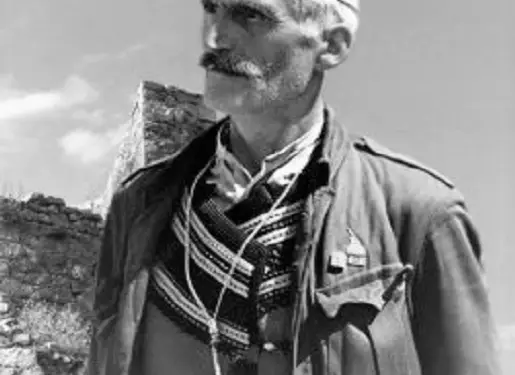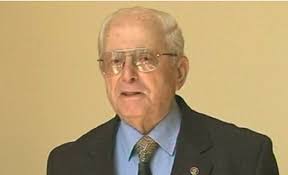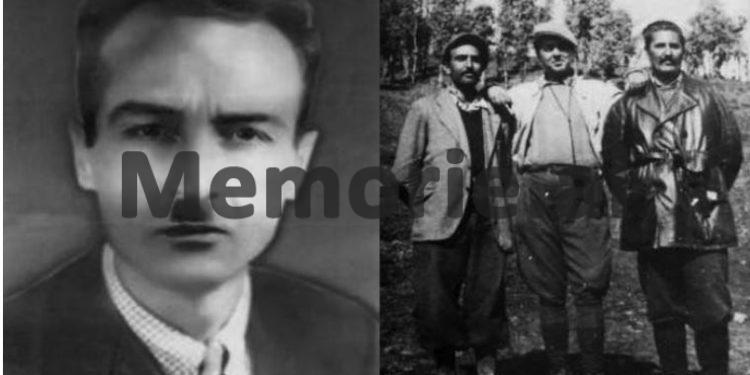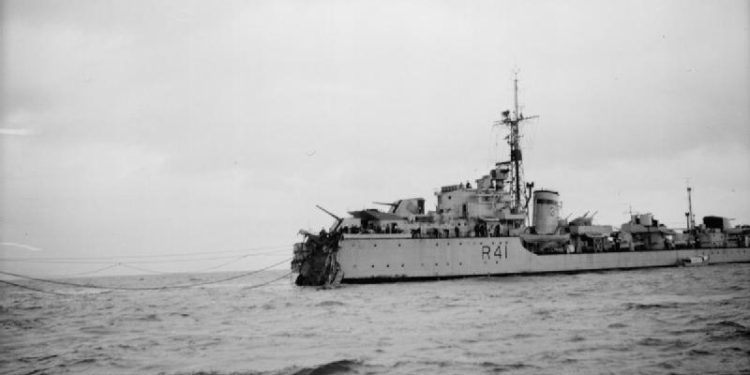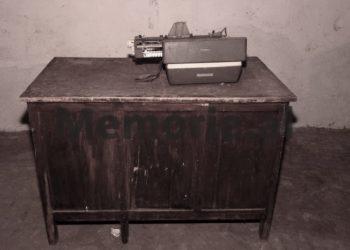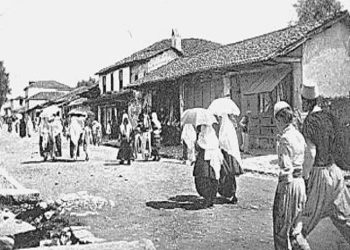From Agim Musta
Part eight
Memorie.al / On the fourth anniversary of the passing away of the well-known historian, researcher, writer and publicist Agim Musta, (July 24, 2019), former political prisoner, his daughters Elizabeta and Suela, gave him the right to exclusivity for the publication, by the online media Memorie.al, of one of the author’s most prominent publications, such as the ‘Black Book of Albanian Communism’. This work contains numerous data, evidence, facts, statistics and arguments unknown to the general public, on communist crimes and terror in Albania, especially against intellectuals, in the period 1945-1991. The publication for the first time of parts of this book is also the realization of one of the bequests of the historian Agim Musta, who, from the beginning of 1991 until he passed away, for nearly three decades was engaged with all his powers, working to raise collective memory, through book publications and publications in the daily press. All that voluminous work of Mr. Agim Musta, concretized in several books, is a contribution of great value to the disclosure of the crimes of the communist regime of Enver Hoxha and his successor, Ramiz Alia. A good part of the publications of Mr. Agim Musta, is also translated into English. Thanking the two daughters of the late Musta, who chose Memorie.al, to commemorate their father, from today we are starting the publication, part by part, of the “Black Book of Albanian Communism”.
Continues from last issue
-Political trials of the Albanian communist regime-
(1945-1991)
The military courts hit Shkodra, Korça, Dibra, etc. with an iron fist.
During the period 1945-1948, in all the main cities of Albania and in the centers of the sub-prefectures, such as; in Delvina, Përmet, Lushnje, Fier, Krujë, Kavajë, Lezhë, there were military courts that handed down final death sentences. From those courts, about 1,500 people have been sentenced to death and over 10,000 others have been sentenced to heavy prison terms. In no city of Albania, the sword of Damocles, Hoxha, fell as cruelly as in the city of Shkodra.
Not only in Albania, but in the entire communist Balkans, there was no city with 13 remand prisons. They returned to prisons: Schools and churches, assemblies of monks and nuns, even private houses, among residential neighborhoods. The “cleansing” operations were directed by the famous executioners: Mehmet Shehu, Shefqet Peçi, Zoi Themeli, Vaskë Koleci, and others, the oppressors of the Albanian people. Deputy Prime Minister and Minister of Internal Affairs, Koci Xoxe, ordered; “You have full authority to kill, cut, burn, just clear the north of the reactionaries”!
The Shkodra Security Investigation Office worked 24 hours a day without stopping. From the 13 investigative prisons, night and day, the screams of the victims, who were being tortured, could be heard. The inhabitants of the neighborhoods felt their flesh shudder and their hair stood on end, from the screams of the guilty without guilt. Petro Ballati, Rasim Dedja, Nesti Kopali, Hys Zaja, Zoi Shkurti, Lilo Zeneli, Xhevdet Miloti, Fadil Kapisizi, Iljaz Haxhia, etc., sons of the communist hell, had turned into human butchers. Many have been those who gave their lives during torture at their hands.
Those who remained alive were dragged by policemen to courtrooms. Broken eggs, stones and bottles were pelted on the streets by mobs of jackasses, incited by the secretaries of the party’s grassroots organizations. What humiliating calls were addressed to those unfortunates, who had worked with honor and piety all their lives, for this country and for this people?! But who were those facts that became the prey of bloodthirsty beasts? They were respected clerics such as: Father Fausti, Father Dayani, Father Meshkalla, Hafëz Ali Kraja and many others.
They were flag bearers and patriots, like; the legendary hero of Kelmendi, the bannerman of Vermoshi, Prek Cali, a mythological giant 2 meters and 20 cm. tall, pure patriot who, with superhuman sacrifices and efforts, made Vermoshi in 1913 remain within the borders of the Albanian state. Albanian state officers such as; Llesh Marashi, Halit Kazazi, Pjetër Berisha, etc., had established order in Albania, emerging from the chaos of the First World War.
Intellectuals of all fields, such as: Ndoc Saraçi, Musa Gjylbegu, Haki Bushati, Nino Kurti, and many others. Schoolchildren and students, such as: Martin Camaj, Fran Miraka, Rauf Uruçi, Ahmet Bushati, Sami Repishti and many others, some of whom were teenagers, without removing the razor from their cheeks. But who were the judges and prosecutors who read you the indictments copied from the Stalinist trials of the 1930s in the Soviet Union?
Mustafa Ijazi, former court clerk with unfinished secondary education. He entered the path of crime and with the support of the lieutenant of the Security, he had undertaken to send to the “other world” whoever the party – state asked him to do. Misto Bllaci, semi-illiterate, professional killer, who with great difficulty read the sentences given to him Aranit Cela, the handsome prosecutor, who very quickly reached the top of the Albanian communist “justice”.
It is said that he has given 500 “Kolpo di grazie” during his career as a prosecutor. Even to this day, like a katana, he walks the streets of Tirana, without a thorn entering his foot. The courts of Shkodra have also addressed Namik Qemali , Hys Zaja, Tonin Miloti, Subi Bakiri, etc., all officers of the Security, with hands stained with blood. To silence the lawyers, their clients, the courageous lawyer, Myzafer Pipa, was arrested in the courtroom, who was cruelly tortured until he died in the cells of the Security.
In order to create an alibi, in the dead of night, the body was taken outside the walls of the investigation, with a bullet in the back, which was allegedly killed during the attempt to escape. In order to traumatize the city’s population, those condemned to death, bound hand and foot with handcuffs and ropes, paraded through the main streets of Shkodra, like a solemn procession, towards Zalli i Kiri, accompanied by the humiliating screams of the murderous mobs, which stood on both sides of the roads.
Even today, more than 60 years have passed since those crazy days; there are people who keep alive in their memory the crazy events and the deeds of the monsters of the Albanian Communist Security. Unfortunately, with the works of art and literature of 17 years of Albanian pluralism, those horrors occupy a very small place, compared to other events of that sad time…!
But let’s go back to the military trials, in other cities of the country. Even Korça was not far behind Shkodra. In the district of Korça, during the years 1945-1948, over 1600 people were arrested and sentenced. Most were colonists, devolinj and pogradecarians. Many buildings in the city were turned into remand prisons, except for the old prison of Korca, built in the First World War. A part of the Metropolis, the “Manastiri” hotel, Rrako’s house and other private buildings were turned into investigative prisons.
The Military Trial of Korça was presided over by former baker, Security Major Niko Çeta and the prosecutor, the infamous sadist, Captain Nevzat Haznedari. This trial, within a 2-year period, has given 140 death sentences. Nationalist intellectuals were sentenced to death and executed: Faslli Frashëri, Muamerr Liço, Nafiz Babani, Xhevat Starova, and many others. The absurdities of that court-martial, directed by the ordinary baker, had no end.
One day, a deaf-mute peasant was sentenced to ten years in prison for making anti-communist propaganda. The defense lawyer, Ali Selenica, stood up and protested energetically, to put an end to such absurdities, turning the court sessions into a macabre tragedy-comedy, which has never happened in any time and in any place in the world.
At the end of the session, lawyer Selenica was handcuffed and after several weeks of torture, she was sentenced to 20 years in prison! The life of the respected jurist, Ali Selenica, a graduate of the University of Rome, ended tragically in the Burrel prison. He fell ill with jaundice and instead of being treated; they locked him in a cell and left him there until he died.
In Gjirokastra, the military court was led by the assistant innkeeper Ago Çelo and the prosecutor, the former horse nurse, Bexhet Mema. No human mind, no matter how gullible or naive it may be, will ever believe what happened in Albania with the “justice” of the communist dictatorship.
The trial against Edip Tërshana and his friends
In the district of Dibra, a number of intellectuals and patriots, deceived by communist propaganda, helped the Anti-Fascist Movement, making a significant contribution to the victory of the National Liberation Movement. Beginning after the end of the Second World War, all that was promised to the people by the Albanian communist leadership, turned out to be lies and deceptions.
Kosovo and the Albanian part of Macedonia remained outside the state borders of Albania and in those provinces, the Yugoslav forces with the help of the Albanian communists, exercised a terror that surpassed even the period of the Serbian Kingdom. With the customs union between Yugoslavia and Albania in 1946, with the equalization of the Albanian ALL with the Yugoslav dinar, with the “reforms” made during the years 1945-1946, Albania was returning, not to a seventh republic of Yugoslavia, but to a colony of the communist state of Marshal Tito.
The created situation deeply shocked the patriotic Dibra teacher, Edip Tërshana, who, regardless of death, went to work to create a clandestine anti-communist organization, named “Democratic Union”. With the help of Qenan Dibra, connections were made with the anti-communist organizations that had been created at this time in Tirana. In 1946, Oedipus revealed the platform of the group to the professor of literature, who came on duty to Peshkopi, Mr. Enter Alimerko, who would become Oedipus’ right-hand man, in anti-communist propaganda and one of the main organizers of the “Democratic Union” movement in Dibra district.
Other intellectuals with a democratic philosophy joined the group, such as: the lawyer Jani Konomi, Alqi Nushi and Kozma Gjergo. The group’s activity caught the eye of the Security, which had raised its tentacles everywhere. In the spring of 1947, the sword of Demokleus falls on the group of Oedip Tërshana. Arrested: Edip Tërshana, Hysni Alimerko, Jani Konomi, Alqi Nushi, etc. The cruelest tortures were used on the arrested, starting with a red iron, and ending with hanging from a hook upside down. To escape this endless horror, Edip Tërshana cuts the veins of his hands, but is dictated by the guards, who were able to stop his death.
After 6 months of medieval torture, on November 17, 1947, the trial began in the city of Peshkopia, against the group “Democratic Union”. The military court presided over by Major Myftar Grabova and prosecutor Stavri Grabockë, were instructed to hit with an iron fist, with fabricated accusations, that group of patriots who hurt the homeland and the nation. Before appearing in court, Edip Tërshana, from the investigation cell, addressed the chairman of the party-state, Enver Hoxha, with a letter titled: “Enver! You betrayed”!
Counting all the betrayals that the head of the party-state had committed against the homeland and the Albanian people, during the last three years, Edip Tershana had enraged the dictator and he personally ordered that Oedipus be executed, after being cruelly tortured. In the dock, stood 12 guilty innocents, 12 alienated by torture, who expressed their thoughts, regardless of death.
On November 21, the court gives the death sentence for Edip Tërshana, Hysni Alimerko and Jani Konomi, Alqi Nushi, Rexhep Mborja, Selim Graceni, Adem Shehu, Rifat Dibra, Mahmut Ndreu, Blez Selishta, Ferit Previzi and Munir Shatku, sentenced to imprisonment heavy. After a few days, Edip Tërshana was executed. He went to his death with his head held high. In addition to the prosecutor, the head of the Security, the infamous Kopi Niko, also participated in his execution. The last words of Oedipus were: “Long lives Albania! Down with treason”!
International crimes of the Albanian communist government
The Corfu Channel incident
German forces stationed on the Ionian coast, during 1943, mined the Corfu Channel in order to prevent Anglo-American ships from landing on the shores of the Ionian Sea. By the end of 1944, when the German army had withdrawn from Greece and Albania, English minesweepers cleared the Corfu Channel of mines, and during 1945-1946, no warships or merchant ships were damaged in the Channel. Corfu.
To the surprise of many experts in this field, on October 22, 1946, two English warships; “H.M.S. Saumarrez’ “H.M.S. Volage”, sailing in the Corfu Channel, fell into mines and were seriously damaged. 43 English sailors were left hanging and 29 wounded. An investigative commission of experts from the British Admiralty and the Greek Navy found that the mines were not a week old that were placed in the Corfu Channel and they were German-made mines left on the Dalmatian coast after the departure of German troops from Yugoslavia. The mines were placed in the Corfu Channel by the Titian Yugoslav navy with the consent and assistance of the communist government of Enver Hoxha.
The issue of the damage to two British ships was brought to the Security Council on March 25, 1947, and based on the indisputable facts presented by the British government, the UN Security Council declared Albania guilty of the Canal incident. Corfu and transferred the case to the International Court of Justice in The Hague. The Hague Tribunal found that: two Yugoslav minelaying ships named: “Mljet” and “Mejline”, had loaded mines in the Yugoslav port of Shebenik on October 16, 1946 and had immediately left for Albania, for the port of Saranda.
On October 20, on a moonless night, assisted by Albanian Security officers, Yugoslav ships, disguised as fishing boats, laid mines in the Corfu Channel. Two days later, on October 22, 1946, the two British warships mentioned above were severely damaged with the loss of 43 English sailors’ lives. At the Hague Trial, the captain of the Yugoslav ship “Mljet” also testified, who escaped from Yugoslavia a few months after the incident and sought political asylum in Western Europe. On April 9, 1949, the Giykata of The Hague gave the decision that qualified the Albanian communist government; responsible for the Corfu Channel incident and obliging him to pay the appropriate compensation.
For this, the British government blocked the gold of the Albanian state (about 24 quintals of florins in bullion) that had been taken from the Bank of Rome by the German army in the fall of 1943. In 1945, the British occupation troops in Germany seized it the Albanian gold deposit and after the Corfu Channel incident, it was kept blocked in the English banks, to compensate the families of the killed and wounded sailors. The solution to the Albanian gold issue was reached in 1994, when the communist dictatorship was overthrown in Albania.
The intervention of communist Albania in the civil war in Greece during the years 1945-1949
The Albanian Communist Government and personally Enver Hoxha in 1948, charged the then Deputy Minister of Internal Affairs, Mr. Myftar Tare, to lead the “Action 10” operation. With this operation, the most devout Albanian State Security officers were engaged, who knew the Greek-Shiptian border well and were prepared for actions inside the Greek territory, not only in sending aid from the communist camp, but also in combat actions . Albanian officers such as Iljaz Lumani, Koço Kazanxhi, Neshat Hysi, Sotir Vullkani, Sotir Mero, Jorgo Koço, Myslim Rroka, Bajram Goni, Sami Hormova, Mihallaq Vangjeli, Hajro Troka, Faik Lamçe, Llambi Treni, Pandi Dishnica and many others, have took part in military actions against the Greek government forces.
In one of these actions, the Security officer Koço Kazanxhiu, (from Durrsak), was captured and wounded by the Greek government forces, who, by the decision of a special Greek court, was sentenced to death and executed in Gregi, on December 27, 1951. The Greek government had raised the issue of Albania’s intervention in the civil war in Greece many times at the UN, even though Albania was not yet a member. During the period 1947-1949, the Greek communist forces, called EAM, handed over several hundred soldiers and officers of the Greek government, captured by them, to the Albanian authorities. Also, to the Albanian government, several thousands of Greek civilians and children taken hostage have been handed over by the EAM-ists, to be used for their evil purposes.
The Albanian government had set up several internment camps in Krujë, Burrel, Seman, Cërrik, etc., and some of them were sentenced to imprisonment and ended up in forced labor camps in Llakatund, Gjadri, Vlashuku, etc. A significant part of them left their bones in the mudflats of Albania, or committed suicide in forced labor camps. In the spring of 1949, by order of the Albanian government, meetings were organized in Fier, Lushnje, Durrës and Tirana, to create an armed regiment of 2000 people, who would be sent to Greece, to fight alongside the Greek communists. . The Chams, called to those meetings, rejected the call of the Albanian communist government, categorically refusing to become flesh for the interests of the Greek communists.
As a response to the disobedience of the Party-State order, 600 Chams were arrested and sent to forced labor camps in Gramsh-Lozhan. From cruel treatment, hard work and diseases, within 10 months, 30 Cham died in this camp and the others who were released were sick and physically exhausted. Memorie.al
The next issue follows




